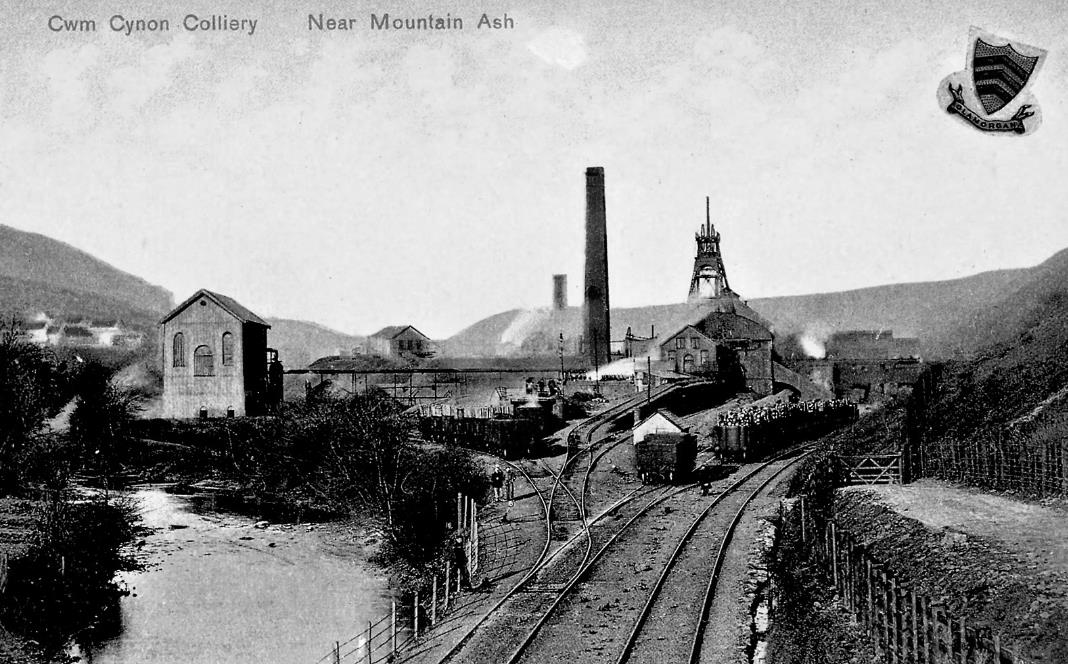 Near Mountain Ash, Cynon Valley (05949792)
Near Mountain Ash, Cynon Valley (05949792)
This pit was located just to the south of Mountain Ash and was sunk between 1889 to1896 to a depth of 1,523 feet by Nixon’s Navigation Coal Company with the manager being James Davies. In 1896 it employed 36 men underground and 30 men on the surface on sinking operations. It worked the Six-Feet seam which it found with a thickness of coal 46 inches, dirt 7 inches, and coal 33 inches. The Four-Feet seam was extensively worked and had a section of coal 66 inches, dirt 4 inches, and coal 16 inches.
Based on the Nine-Feet seam its coals were generally classed as type 201B Dry Steam Coals, usually non-caking, low volatile, low in ash and sulphur content, and were used in steam raising on ships, locomotives, power stations, etc.
The founder of Nixon’s Navigation Coal Company was John Nixon, who can claim to have made the Cynon Valley one of the most important coal-producing areas in the world. Nixon first visited South Wales to carry out a mineral survey for the Marquis of Bute in the Dowlais area, from here he went to work in the French Coalfields, but soon returned to Wales and used his marketing skills to introduce Welsh coal to France. Nixon made enough money out of selling coal to finance his own pits and leased the mineral rights in the Mountain Ash area and sunk the Werfa pit. He then took an enormous gamble and sunk his Navigation pit, a venture that almost ruined him the sinking took seven years to complete with the pit in production in 1860. He continued with the purchase or sinking of other pits in the area, including Cwmcynon and Deep Duffryn before venturing into the Taff Vale to sink Merthyr Vale Colliery. It was linked to both Nixon’s Navigation and Deep Duffryn collieries.
On the 20th of December 1899, James Belpin, aged 16 years, and a haulier, was run over and killed by trams. On the 10th of February 1908 Dennis Hallahan aged 25 years and Ben Evans 28 years were killed under the same fall of roof, also dying in that year were Albert Gibbs aged 28 years on the 7th of January and William Jenkins, aged 23 years on the First of December both died under a fall of roof.
In 1893 the manager was James Davies and in 1908 the manager was F.W. Bell and the pit employed 1,584 men underground and 241 on the surface. In 1913 the Nixon’s Navigation Coal Company owned five pits employing 8,994 men, Cwmcynon employing 1,882 of them. The manager at Cwmcynon Colliery at that time was J.O. Jones. In 1915/6 the manager was A.A. Jenkins. In 1918 it employed 1,337 men underground and 281 men on the surface, and in 1919 it employed 1,689 men. Mr. Jenkins was still the manager as he was in 1930.
This company was a member of the Monmouthshire and South Wales Coal Owners Association. In 1929 Cwmcynon, as well as Nixon’s other pits became part of D.R. Llewellyn’s, Llewellyn (Nixon) Limited and under his control employed 170 men on the surface and 1,270 men underground producing 400,000 tons of steam coal in 1935. The manager at that time was R.C. Morgan.
In 1934 Llewellyn (Nixon) Limited was based at the Navigation Offices, Mountain Ash with the directors being; Sir David R. Llewellyn, W.M. Llewellyn, H.H. Merrett, Sir John F. Beale, T.J. Callaghan and J.H. Jolly. It controlled six collieries that employed 6,280 miners who produced 2,100,000 tons of coal in that year. It was with the same manager in 1938 when the colliery employed 616 men underground and 93 men on the surface and in 1943/5 when it employed 537 men working underground in the Six-Feet and Nine-Feet seams and 107 men working at the surface.
On Nationalisation in 1947 it was brought under the control of the National Coal Board’s South Western Divisions No.4 (Aberdare) Area. At that time the pit employed 98 men on the surface and 391 men underground working the Six-Feet, Nine-Feet and Four-Feet seams and was still managed by R.C. Morgan who remained there until closure.
Cwmcynon Colliery was closed by the National Coal Board on the 7th of January 1949 due to it being uneconomic. It is now the site of an industrial estate.
Some Statistics:
- 1896: Manpower: 66.
- 1899: Manpower: 883.
- 1900: Manpower: 1,058.
- 1901: Manpower: 1,449.
- 1902: Manpower: 1,521.
- 1903: Manpower: 1,656.
- 1905: Manpower: 1,860.
- 1908: Manpower: 1,825.
- 1909: Manpower: 1,825
- 1910: Manpower: 1,835
- 1911: Manpower: 1,892.
- 1912: Manpower: 1,867.
- 1913: Manpower: 1,882.
- 1915: Manpower: 1,689.
- 1916: Manpower: 1,384.
- 1918: Manpower: 1,337.
- 1919: Manpower: 1,689.
- 1920: Manpower: 1,734.
- 1922: Manpower: 1,831.
- 1923: Manpower: 1,937.
- 1924: Manpower: 1,785.
- 1925: Manpower: 1,845.
- 1926: Manpower: 1,948.
- 1927: Manpower: 2,005.
- 1928: Manpower: 1,924.
- 1929: Manpower: 1,500.
- 1932: Manpower: 1,500.
- 1933: Manpower: 1,436.
- 1934: Manpower: 775.
- 1935: Manpower: 1,440. Output: 400,000 tons.
- 1937: Manpower: 658.
- 1938: Manpower: 709.
- 1940: Manpower: 686.
- 1941: Manpower: 648.
- 1942: Manpower: 683.
- 1944: Manpower: 685.
- 1945: Manpower: 644.
- 1947: Manpower: 489.
- 1948: Manpower: 444. Output: 110,000 tons.
- 1949: Manpower: 261. Output: 75,000 tons.
Information supplied by Ray Lawrence and used here with his permission.
Return to previous page
